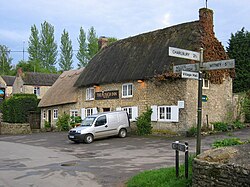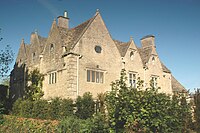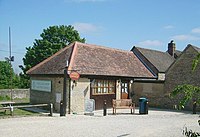Finstock
| Finstock | |
| Oxfordshire | |
|---|---|
 The Plough, Finstock | |
| Location | |
| Grid reference: | SP361166 |
| Location: | 51°50’49"N, 1°28’37"W |
| Data | |
| Population: | 797 (2011) |
| Post town: | Chipping Norton |
| Postcode: | OX7 |
| Dialling code: | 01993 |
| Local Government | |
| Council: | West Oxfordshire |
| Parliamentary constituency: |
Witney |
| Website: | finstock.org.uk |
Finstock is a village in Oxfordshire, found about two miles south of Charlbury. To the north flows the River Evenlode.
The 2011 Census recorded the parish's population as 797.
For most of its history Finstock was accounted a township of the ancient parish of Charlbury.
The name 'Finstock' is believed to mean 'Woodpecker place',[1] from the Old English fina (wood[pecker) and stocc.
Contents
Parish church
right|thumb|200px|Holy Trinity Holy Trinity, the Church of England parish church, is a Gothic Revival building of 1841.[2] Its ornate chancel was added in 1905 and its elaborate south window by the architect Percy Richard Morley Horder in 1929.[2] T. S. Eliot came to Finstock to be received into the Church of England. William Force Stead was a fellow American and came to Britain as an American consul but soon found that his real bents in life were literature and religion. He was ordained, became chaplain of Worcester College, Oxford and after meeting Eliot in 1923 (with whom he shared a love of cats) steadily drew him towards Anglicanism and agreed to baptise him.
History
Archaeology
A palaeolithic biface was found in the parish near Mount Skippett in 1983.[3] The artefact was found in isolation without any associated archaeological materials so it is difficult to date, but its manufacture shows a mixture of techniques from the Lower Palaeolithic (older than 200,000 years ago) and Middle Palaeolithic (200,000 to 45,000 years ago) periods.[4]
Roman coins and Romano-British potsherds have been found in the parish.
Manor
It is thought that there was a settlement of some kind here at the time of the Domesday Book of 1086. In 1135 the village of Finstock is referred to as Fynstoke. In this period, the village formed part of the manor and parish of Charlbury. In the early 16th century the manor of Charlbury and its land, including Finstock, was held by Sir Thomas White, a London tailor who founded St John's College, Oxford, in 1555. The manor was then included in the college's endowment. As the college lands were owned by an absentee landlord, the land was leased to many people including the Lee family of Ditchley Park[5] from 1592 to 1776. The college then resumed direct control until 1857, when the lordship of the manor passed to Francis Spencer, 2nd Lord Churchill of Wychwood, the owner of Cornbury Park.[6]
Finstock Manor House is 17th-century and has a date stone saying 1660. It is an L-shaped house with three gables on each of its longer sides and an attic window in each gable. All the attic windows in the gables are elliptical[2] and one is oeil-de-boeuf. The roof is of Stonesfield slate. The house is a Grade II* listed building.[7]
Social history
Finstock, together with its neighbours Charlbury, Fawler and Leafield, lay in a clearing of Wychwood Forest that used to stretch from Woodstock to Burford. Much of the forest land was cleared for growing arable crops and during the Middle Ages barley was the main crop in Finstock. Other land was used for sheep grazing and many of the people of Finstock were involved in the wool industry — the carding being done by men and boys and the spinning by women. Glove making at the village hall site by the women and agricultural labouring on nearby land by the men and boys, used to be the principal occupations of the people of Finstock in the earlier part of the 20th century. Finstock is now a separate civil and ecclesiastical parish,[8] its population mostly living along the sides of a large triangle formed by the main Witney-Charlbury road (west to north), School Road (east) and Finstock High Street (south). Much in-filling with new buildings has further completed the triangle and four new estates were built during the 20th century. The farming now is mainly arable, barley, wheat and oilseed rape, but there is still some mixed farming.
The building of the Oxford, Worcester and Wolverhampton Railway along the Evenlode Valley began in 1845 and the line was opened in 1853. It passes through the northeastern edge of Finstock parish about half a mile from the village. Originally its nearest station was Charlbury, about two miles from Finstock. The Great Western Railway took over the line in 1862 and opened Finstock railway station in 1934.
About the village
Finstock has one public house: The Plough Inn.[9] A second, The Crown, has been closed and converted into a house. Finstock has a combined village shop and sub-post office.
Finstock railway station is on the Cotswold Line. The station is between Finstock and the hamlet of Fawler. Pulhams Coaches operate a semi-regular bus service through Finstock, between Witney and Chipping Norton.
Outside links
| ("Wikimedia Commons" has material about Finstock) |
References
- ↑ Key to English Place-Names: Finstock
- ↑ 2.0 2.1 2.2 Sherwood & Pevsner 1974, p. 605.
- ↑ Tyldesley 1983, p. 143.
- ↑ Tyldesley 1983, p. 144.
- ↑ Ditchley website
- ↑ Cornbury Park
- ↑ National Heritage List 1367894: Finstock Manor House (Grade II* listing)
- ↑ Finstock website: Parish church
- ↑ The Plough Inn
- Adamson, Donald; Sencourt, Robert (1971). T. S. Eliot: a Memoir. London: Garnstone Press. ISBN 0-900391-81-2.
- A History of the County of Oxford - Volume 10 pp 127-157: Parishes: Charlbury (Victoria County History)
- Nikolaus Pevsner: The Buildings of England: Oxfordshire, 1974 Penguin Books ISBN 978-0-300-09639-2
- Tyldesley, Joyce (1983). "A Paleaolithic Biface from Finstock, Oxfordshire". Oxoniensia (Oxfordshire Architectural and Historical Society) XLVIII: 143–144.
- Reaney, P H (1969). The Origin of English Place Names. Routledge & Kegan Paul.
- Clark Hall, John R. (1916). A Concise Anglo−Saxon Dictionary, Second Edition. The Macmillan Company.

